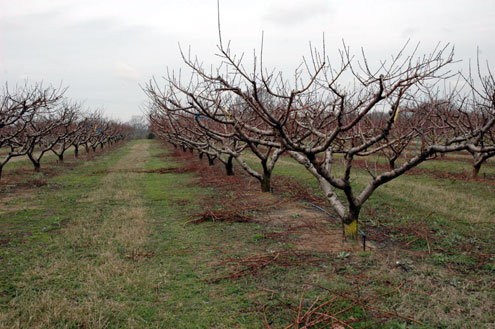BRYAN — Not long after winter settled in, plant catalogues arrived, and with them may come thoughts of grandiose spring plantings.
If a pristine orchard comes to mind, study the realities of fruit and nut tree care, Texas A&M AgriLife Extension Service horticulturists said.
“Site selection is like a marriage,” said Dr. Jim Kamas, AgriLife Extension horticulturist in Fredericksburg. “It’s a long-term commitment.”

Kamas teamed up with AgriLife Extension horticulturists Dr. Larry Stein of Uvalde and Monte Nesbitt of College Station to conduct a Texas Fruit and Nut Orchard Conference recently in Bryan.
Almost 100 people attended the event, which was aimed at helping those “interested in growing fruit for health, wealth or recreation in Texas get started.”
“We covered the basics for novice growers, reviewed fruit varieties for experienced growers and presented new crop opportunities and challenges facing the fruit industry in Texas,” Nesbitt said.
Though agriculture in Texas has traditionally meant row crops and agriculture, the team indicated that varieties of many fruit and nut trees are producing well across the state. According to the 2007 U.S. Census of Agriculture – the most current figures available – Texas has 8,848 orchard farms with 215,794 acres in production.
The three believe there is room for more, especially given the continuing interest in locally produced commodities, but they urged potential growers to plan carefully before making expensive cash outlays to establish a new orchard.
“Not every site is suitable,” said Kamas, showing a picture of a peach orchard that had been planted in a field when it was dry but flooded after a rain. “Trees are perennials. They can’t be rotated every year like a annual crop can.”
Because all perennial plants need well-drained soil, Kamas suggested, one can dig a 36-inch hole, fill it with water and see how long it takes to drain. If the water drains in 12-24 hours, he said, the soil is suitable. If it takes longer than that, it does not drain well enough for trees.
Kamas, who is an expert on stone fruits such as peaches and plums, said potential growers also should consider climatic conditions in an area, such as whether it is prone to hail storms, tornadoes or drought.
“First think about proximity to market so that you don’t try to sell your crop in the middle of Timbuktu,” he said. “Avoid the temptation to farm where you live. Rather, live where you farm.”
Stein, who discussed apples, persimmons and pears, said no matter the fruit crop planned, “water has to be at the top of the list if you are thinking of planting.”
And not just the availability of water, he said, but the quality is important.
“You need to know the chemical composition of your water,” he said. “Run your well for an hour and then take a sample. Put it in a sterile baby bottle and get it to a lab for analysis.”
Stein said poor water quality can lead to stunted growth, tree dieback and smaller fruit and leaves.
He said watering a tree at planting is important, even if the soil is wet at the time.
“If you plant trees in the winter when they are dormant, you don’t have to water every day, but when they leaf out, get on a regular watering schedule,” he said.
Weeds represent another challenge for orchards, Nesbitt said, pointing to research which showed that even one weed per tree reduced growth up to 70 percent.
He compared methods of removing weeds, such as mechanical, biological, chemical and organic, and said each may have benefits for particular situations and seasons.
The horticulturists said that potential orchard growers also should research what variety of a particular fruit or nut tree will work best for an area.
Extensive information about growing fruit and nut trees in Texas is available from the horticulturists at http://aggie-horticulture.tamu.edu/fruit-nut/.